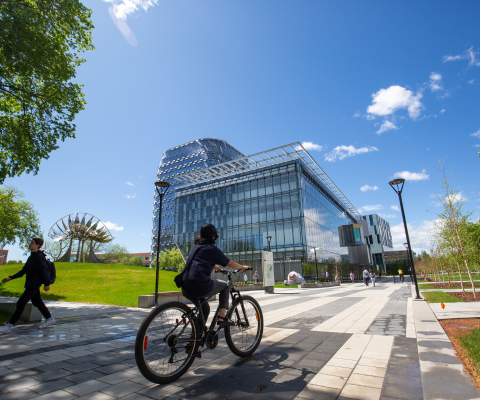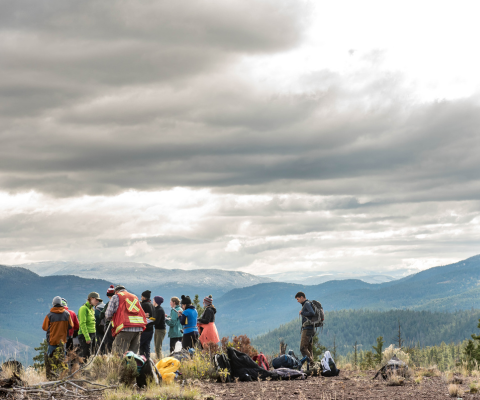Keep the umbrella handy to weather the next storm

This op-ed was published in The Hill Times on September 15, 2021
By Vivek Goel, President of the University of Waterloo and Chair of the Expert Advisory group on the Development of a pan-Canadian Health Data Strategy.
Investing for a rainy day is hard for governments who are often judged on “what have you done for me lately.” This is why adequately preparing for rare events like global pandemics is challenging. The better prepared we are, the less likely we will see really bad outcomes. When we don’t see bad outcomes, we tend to stop investing in preparedness.
What our experience with CO-VID-19 has demonstrated is that we not only need to be prepared for events like global pandemics, but also we need to be able to mount flexible responses that can quickly adapt to new challenges.
That requires not just investing in specific resources that we know we will need, like personal protective equipment, or laboratories. It also requires that we invest in capacity that can respond to new or changing threats. Our research community represents the kind of capacity that can be mobilized for this type of adaptive response.
When we think about CO-VID-19 vaccines, our progress to date is really quite remarkable. At the start of the pandemic, public health experts, including myself, were anticipating four to seven years before a vaccine would be available. We are now a year and a half into the pandemic, and 83 per cent of Canada’s eligible population have received at least one dose. This work was built on decades of research — of fundamental science — that led to the development of mRNA vaccines.
Late in 2020, detecting and combatting SARS-CoV-2 variants of concern became a new challenge in pandemic management. The United Kingdom, through ongoing investments in public health laboratories, genomics and information systems, was able to detect and manage variants quickly. In Canada, we scrambled to pull together the necessary capacity. Through support from the federal government, researchers at universities and colleges have played a critical role in partnering with public health colleagues to help fill the gaps where Canada’s public health system lacked capacity.
The Canadian government recognized the importance of academia in its pandemic response, directing funding in our national strategy to address variants of concern into collaborative, multi-institutional teams of experts. The Canadian COVID Genomics Network (CanCOGeN), created by Genome Canada, is a great example of a cross-sector partnership leveraging existing laboratories and expertise to drive public health investigations and take public health action rapidly. CanCOGeN has established a pan-Canadian, cross-agency network for large-scale genome sequencing, co-ordinating this work across universities and research hospitals. Our clinical and public health system did not have enough capacity to do this alone, so research capacity was mobilized to meet these needs.
The CIHR-funded COVARRNet is a network of researchers across Canada dedicated to addressing the threat of emerging SARS-CoV-2 variants. The network facilitates rapid response research by quickly answering critical questions about the variants, such as: Are these variants more transmissible? What is their likelihood to cause severe cases of COVID-19? What is their resistance to vaccines? The findings from the teams in the network are then given to decision makers in Canada and globally with guidance around drug therapy, vaccine effective-ness, and other public health strategies.
There are several other examples of successful national networks that bring the research community together to fight the pandemic. I was honoured to lead the development of CanCOVID last year, which brought together a network of active researchers, academics, patient partners, decision makers, and industry partners dedicated to an evidence-informed response to the pandemic. CanCOVID was able to help convene researchers working across the country in different disciplines to collaborate on the challenging issues that we faced.
Additionally, work coming directly out of Canadian universities continues to be imperative in addressing and containing the pandemic. At the University of Waterloo, experts at our School of Pharmacy are working to track the efficacy of vaccines against variants of concern. Beyond the variants, Ryerson University’s CO-VID19MisInfo.org Portal counters COVID-19 related misinformation by identifying it through a misinformation dashboard, and by providing the public with the correct information. Mathematical model-ling data, such as the work out of the CanMOD network hosted at Simon Fraser University, among others, continues to play a key public service in helping to predict local, regional, and national case counts and trends.
These are just a few examples of the many ways the postsecondary sector plays an immediate and tangible role in combatting COVID-19.
Over the next decade, governments will have to grapple with difficult decisions on funding as we try to make up for the billions of extra dollars we’ve spent dealing with the impact of the pandemic. Once the pandemic clouds clear, it’s inevitable that public research budgets will come under scrutiny. But cutting research budgets is tantamount to throwing away your umbrella when the rain stops.
Of course, every public sector organization is going to need to play a role in reducing the deficit in future. But the question for all Canadians is this: would you rather know you have an umbrella in the house if you need it, or brave the next storm without cover?
About Universities Canada
Universities Canada is the voice of Canada’s universities at home and abroad, advancing higher education, research and innovation for the benefit of all Canadians.
Media contact:
Lisa Wallace
Assistant Director, Communications
Universities Canada
[email protected]
Tagged: Research and innovation
Related news
-

Urgent action for our publicly-funded universities critical to Canada’s economic stability and growth
-

Outstanding discoveries by Black researchers in Canada
-

Universities are advancing technology through international partnerships
-

Global university partnerships are finding solutions to the climate crisis
